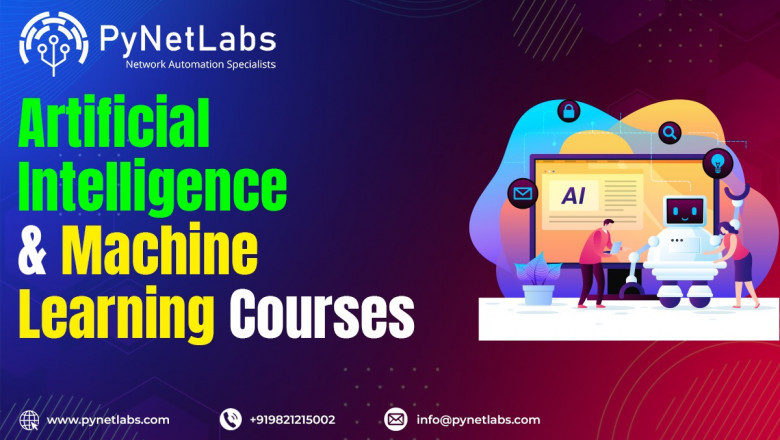views
Artificial Intelligence (AI) and Machine Learning (ML) are reshaping our world, revolutionizing industries, and unlocking unprecedented opportunities. Let’s dive deep into this fascinating journey of future tech and uncover its transformative potential.
Introduction to Artificial Intelligence and Machine Learning
What is Artificial Intelligence (AI)?
Artificial Intelligence refers to the simulation of human intelligence in machines programmed to think, learn, and solve problems. From voice assistants like Alexa to complex data analysis, AI’s scope is vast and continually growing.
Understanding Machine Learning (ML)
Machine Learning, a subset of AI, focuses on teaching machines to learn from data without being explicitly programmed. It powers recommendation engines, fraud detection systems, and even self-driving cars.
The Relationship Between AI and ML
AI (Artificial Intelligence) is the broader concept, while ML (Machine Learning) serves as the method to achieve AI. Think of AI as the goal and ML as the journey. Together, Artificial intelligence & Machine learning drive groundbreaking innovations, powering smarter systems, data-driven decisions, and automation across industries.
The Evolution of AI and ML
Early Beginnings of AI
AI traces back to the 1950s, with early efforts centered on symbolic reasoning and problem-solving.
The Rise of Machine Learning
The 1990s and 2000s marked ML’s rise, driven by improved algorithms and access to massive datasets.
AI and ML in the 21st Century
Today, AI and ML are integral to cutting-edge technologies like robotics, quantum computing, and advanced analytics.
Key Concepts in AI and ML
Supervised Learning vs. Unsupervised Learning
Supervised learning uses labeled data, while unsupervised learning identifies patterns in unlabeled datasets.
Deep Learning and Neural Networks
Inspired by the human brain, deep learning involves multilayered neural networks that excel in image recognition and speech processing.
Natural Language Processing (NLP)
NLP enables machines to understand and generate human language, forming the backbone of chatbots and translation services.
Applications of AI and ML in Everyday Life
AI in Healthcare
AI aids in early disease detection, personalized treatments, and efficient medical imaging analysis.
ML in Finance and Banking
Machine learning strengthens fraud detection, risk assessment, and algorithmic trading.
AI for Smart Homes and IoT Devices
From smart thermostats to security cameras, AI transforms how we interact with our homes.
The Role of AI and ML in Business Transformation
Enhancing Customer Experiences
AI-powered chatbots and personalization tools improve customer satisfaction.
Predictive Analytics for Better Decision-Making
ML-driven insights guide businesses in anticipating market trends and making informed decisions.
Automating Repetitive Tasks
AI and ML optimize workflows by automating mundane, repetitive tasks, freeing up human resources for strategic roles.
Ethical Challenges and Considerations
Bias in AI Systems
Bias in training data can lead to discriminatory outcomes, requiring vigilant oversight.
Privacy Concerns in ML Applications
Data privacy is a growing issue, demanding robust measures to protect user information.
Ensuring Transparency and Accountability
AI systems must be explainable to maintain trust and accountability.
Skills You Need for a Career in AI and ML
Programming and Mathematics
Master Python, R, or Java, and strengthen your foundation in calculus and linear algebra.
Knowledge of Algorithms and Data Structures
Understanding algorithms is essential for solving complex problems.
Understanding AI Frameworks and Libraries
Familiarize yourself with TensorFlow, PyTorch, and similar tools.
Learning Resources and Tools
Online Courses and Certifications
Platforms like Coursera and edX offer comprehensive AI and ML courses.
Popular AI and ML Tools
Experiment with tools like Jupyter Notebooks and Scikit-learn.
Building Your First AI Project
Start small—create a simple chatbot or a prediction model to apply your learning.
The Future of AI and ML
AI and Autonomous Systems
Self-driving cars and drones represent the next wave of autonomous tech.
The Role of AI in Sustainability
AI enhances renewable energy management and combats climate change.
ML Advancing Personalized Technology
From adaptive learning systems to customized entertainment, ML is revolutionizing personalization.
FAQs
-
What are the differences between AI and ML?
AI is the broader field of creating intelligent systems, while ML focuses on enabling machines to learn from data. -
How is AI being used in healthcare?
AI improves diagnostics, treatment personalization, and medical imaging accuracy. -
What are the key ethical concerns surrounding AI?
Issues include data bias, privacy breaches, and lack of transparency. -
How can I start learning about AI and ML?
Begin with online courses, hands-on projects, and studying popular AI frameworks. -
What does the future hold for AI and ML?
The future includes advanced automation, sustainability solutions, and enhanced human-machine collaboration.
Conclusion
AI and ML are not just buzzwords; they are the pillars of future tech. Whether it’s transforming industries or simplifying daily life, their impact is profound and far-reaching. By embracing AI and ML, we are not just stepping into the future—we are shaping it.






















Comments
0 comment